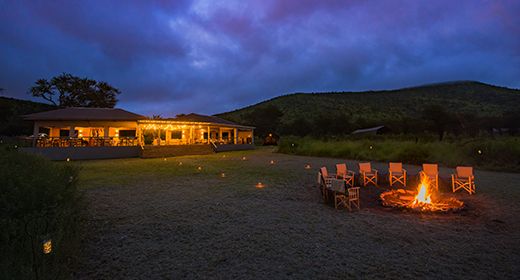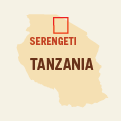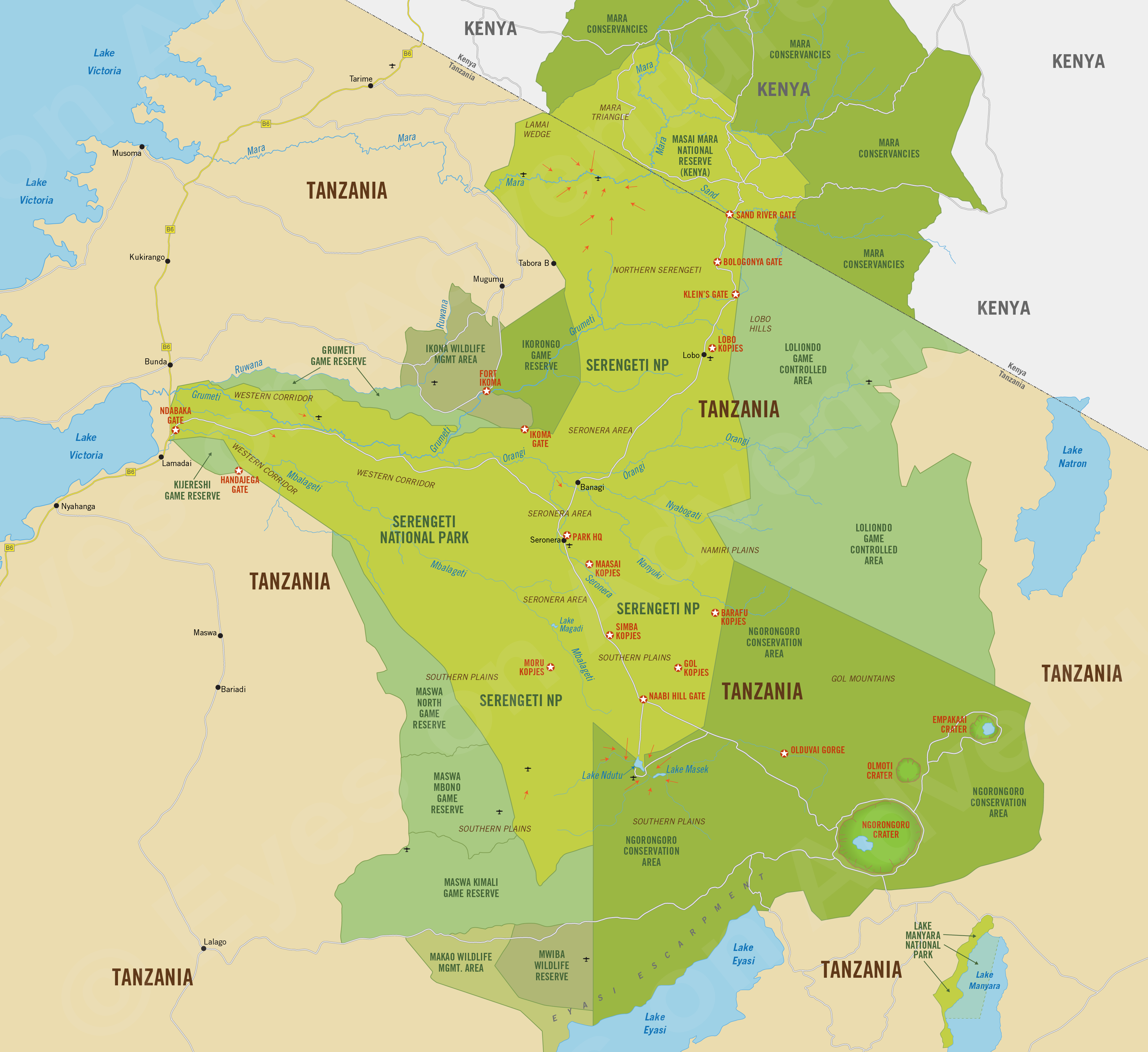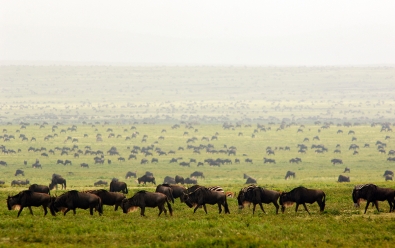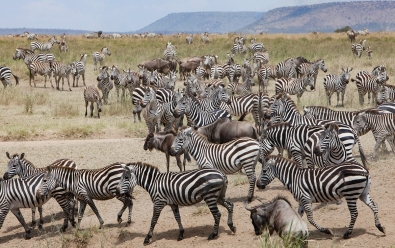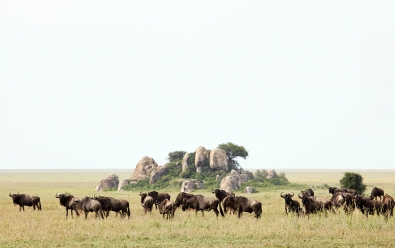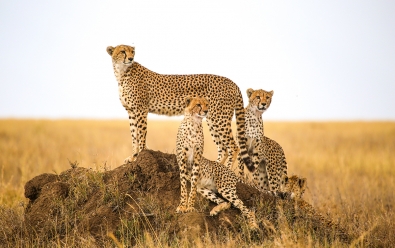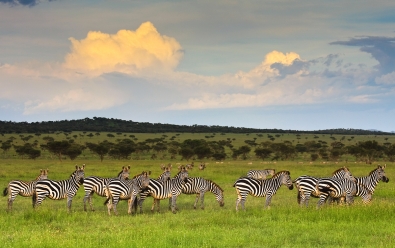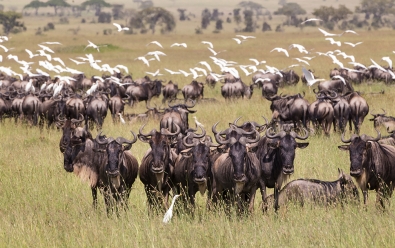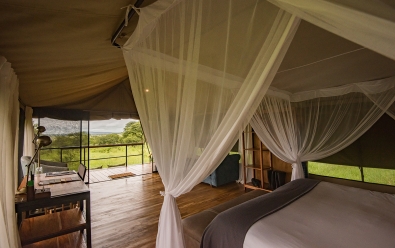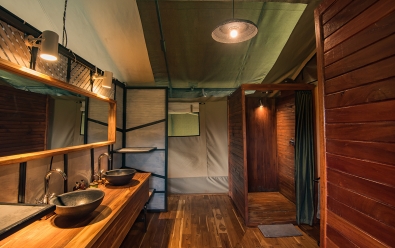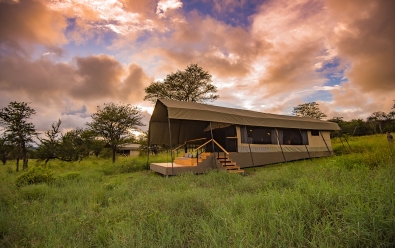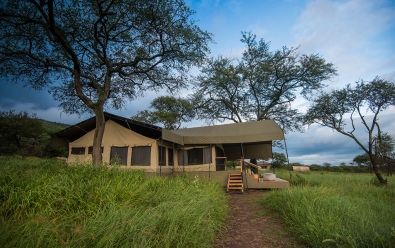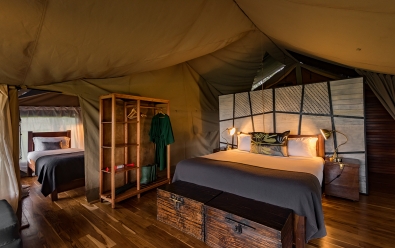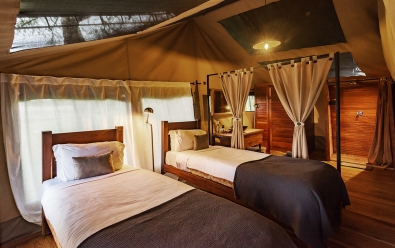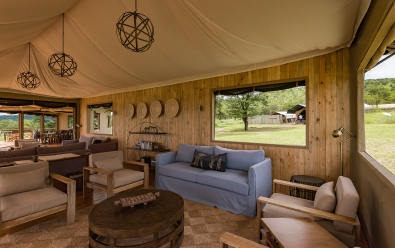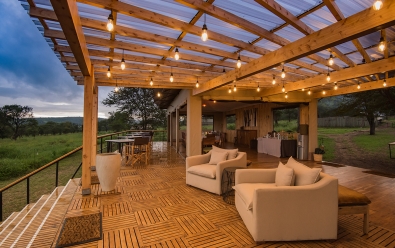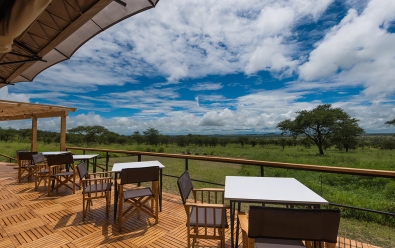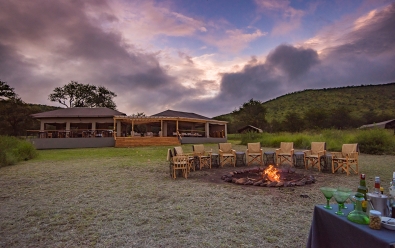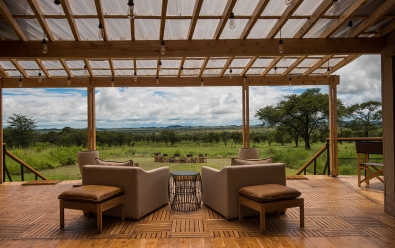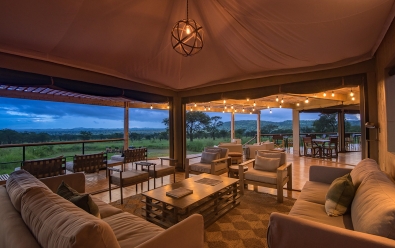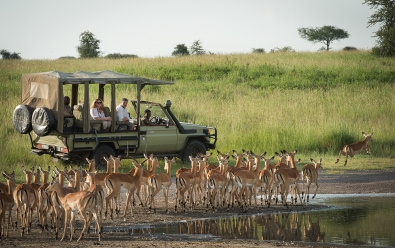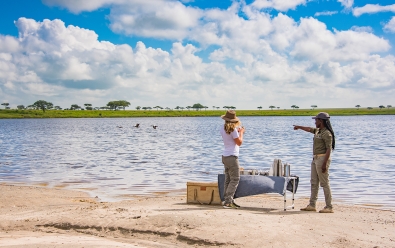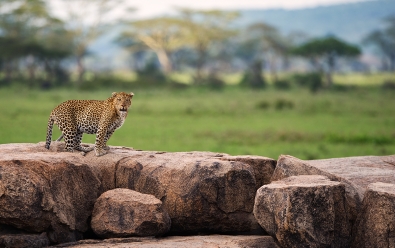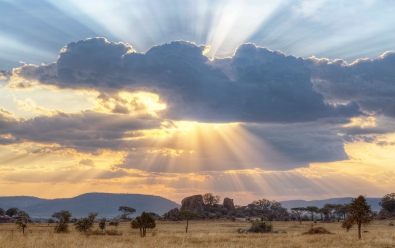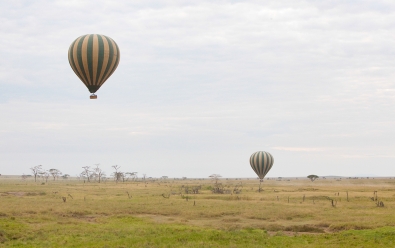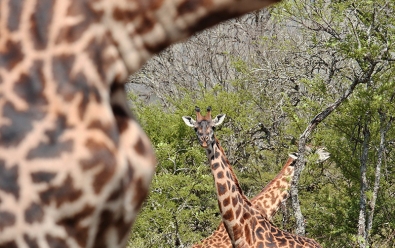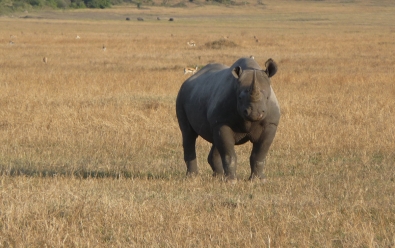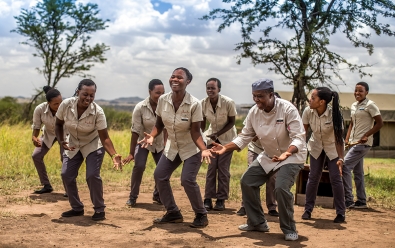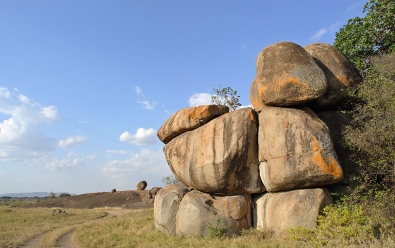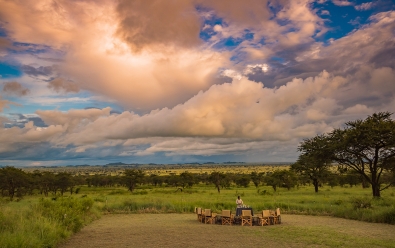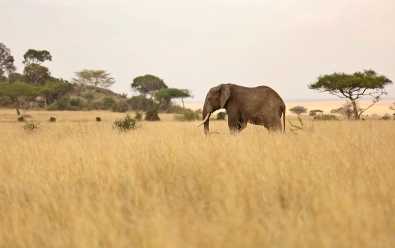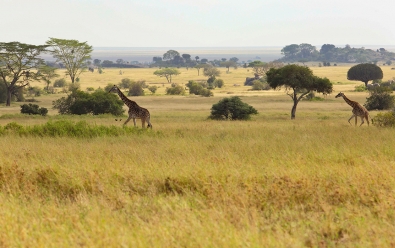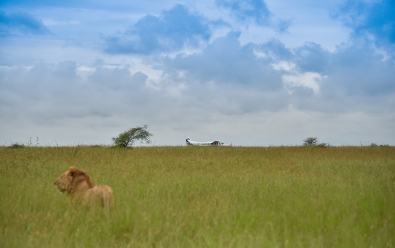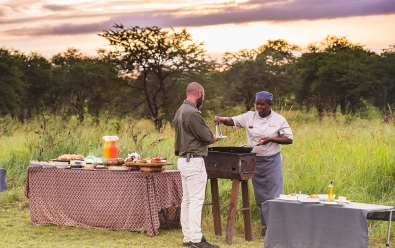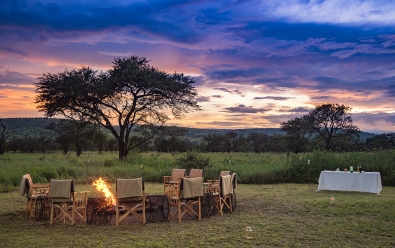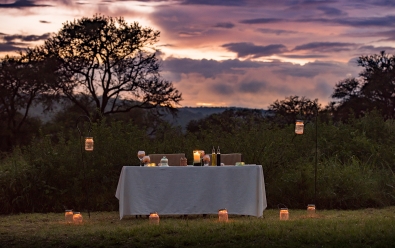Dunia Camp
Highlights
- Excellent resident wildlife viewing including the Big Five
- In the path of the Great Migration of two million herbivores
- Women empowerment camp run entirely by local women
- Expeditions to Moru Kopjes, Lake Magadi, and the Southern Plains
Location
- Central / Seronera Sector
- Serengeti National Park
- Northern Tanzania
Dunia is a classic tented camp located in the Central Serengeti, close to both Moru Kopjes and Lake Magadi and in the path of the annual migration of two million herbivores.
The camp is ideally positioned for viewing the annual migration of over two million herbivores, which are at their peak in this area during April and May (which is also the period of the long rains). The great masses of wildebeests and also some zebras can often be seen grazing right in the camp and around the guest tents.
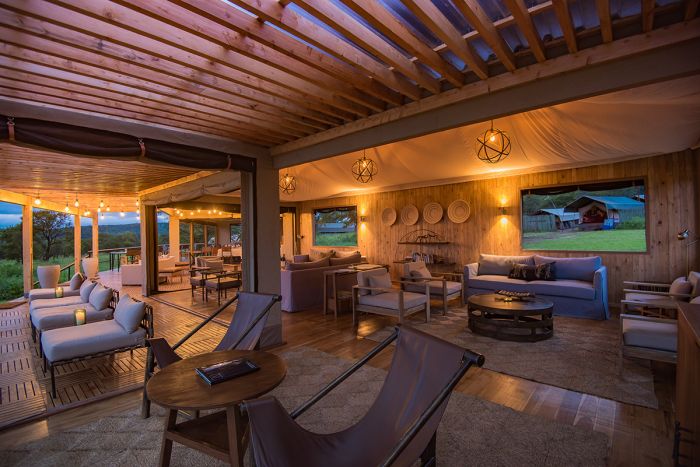
Main area lounge at Dunia Camp.
Dunia's location is close to one of the Serengeti's most interesting, yet seldom visited natural sites, the 'Moru Kopjes'. This spectacular collection of giant, granitic boulders has long been a spiritual place for indigenous humans inhabiting the region, including the modern-day Maasai people.
The camp is also an easy drive to Lake Magadi, which seasonally hosts flamingos and other waterbirds. The Serengeti's' southern plains, which are the breeding grounds of the wildebeest, are also reachable on a game drive.
Outside of the migration months, the area is home to plentiful wildlife, including lion, leopard, cheetah, spotted hyena, topi, zebra, giraffe, buffalo, hartebeest, Thomson's and Grant's gazelle, warthog, and more. Rhino are occasionally seen.
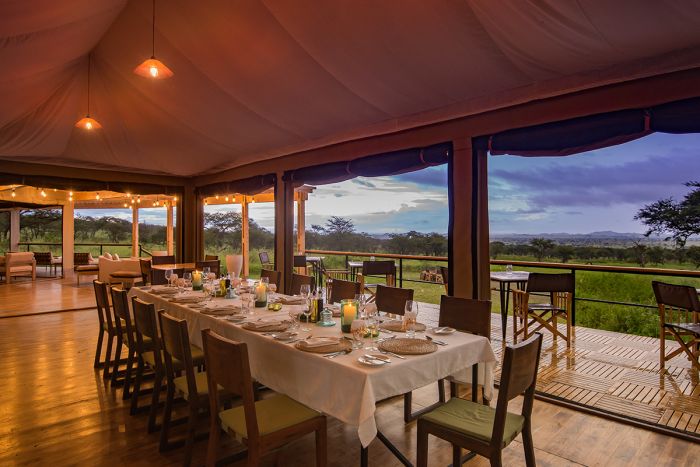
Main area dining at Dunia Camp.
Activities at Dunia Camp include daytime game drives, excursions to explore the Moru Kopjes and Lake Magadi, birding, hot-air ballooning, and cultural experiences with a local Maasai tribe. Families with children are welcome and special activities for children are offered.
Dunia's guest accommodation includes 8 classic safari tents, one of which has two bedrooms and is designed for a family. The tents are comfortable, include en-suite facilities with hot and col running water and flush toilets. A split-level front deck with a double-wide daybed offers a relaxing place to spend the midday while watching for wildlife.
The wooden and canvas main guest area includes a lounge, dining space, and bar that open onto a viewing and dining deck.
Dunia is the only camp in Africa run entirely by women and the team is an inspirational example of what women can achieve in a male-dominated industry. Watch the video at the top of the page for more info.
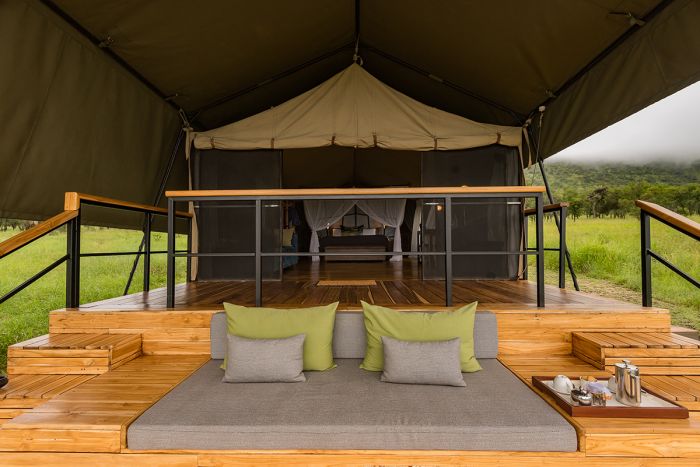
Guest tent veranda and view to bedroom at Dunia Camp.
About the Serengeti
The Greater Serengeti is part of an extensive ecosystem that includes Serengeti National Park, the Ngorongoro Conservation Area, and other reserves, wildlife management areas, and game controlled areas.
The Greater Masai Mara (directly to the north in Kenya) includes the Masai Mara National Reserve, as well as numerous private Mara conservancies. Together, the combined Greater Serengeti-Mara ecosystem, which combines the areas described above, covers roughly 15 000 square miles (39 000 sq kms).
The Serengeti-Mara is home to a very large number and diversity of wild animals and is also the location of the well-known "Great Migration" of over 2 million herbivores (read more below). This is arguably Africa's greatest overall wildlife destination.
Wildlife densities in the Greater Serengeti are some of the highest in Africa, with commonly seen herbivores including blue wildebeest, plains zebra, Thomson's gazelle, topi, Grant's gazelle, hartebeest, giraffe, elephant, buffalo, impala, waterbuck, bushbuck, warthog, and many others. Predators seen often include lion, leopard, spotted hyena, cheetah, serval, and jackal. Hippo and crocodile are found in large numbers in the larger rivers, including the Mara River and the Grumeti River.
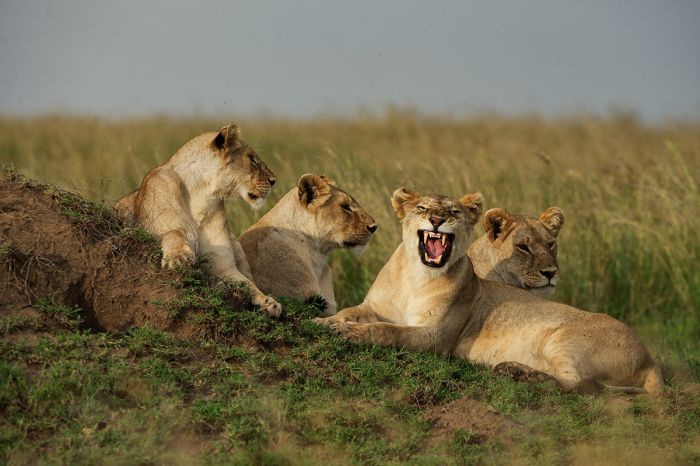
Lions in the Serengeti seen on a game drive from Dunia Camp.
About Seronera
The central sector of the Serengeti is called Seronera. Tributaries of the Grumeti River flow through Seronera, providing ideal habitat for leopards, which are here in good numbers. Between the rivers are wooded valleys and savanna grasslands, which attract all of the Serengeti's wildlife, including well-known lion prides, leopard, spotted hyena, jackal, serval, topi, impala, hartebeest, buffalo, giraffe, Grant's gazelle, Thomson's gazelle, waterbuck, reedbuck, dik-dik, warthog, and others.
Like the Serengeti's southern grasslands, Seronera has great wildlife throughout the year, but the animal densities are at their highest during the rain season (November to May), when the fertile soils produce rich grasses for the migrating herds of wildebeest and zebra. The wildebeests use the southern plains as their birthing grounds during January and February. After some time for the babies to grow stronger, the herds begin moving slowly north, usually reaching Seronera sometime in April.
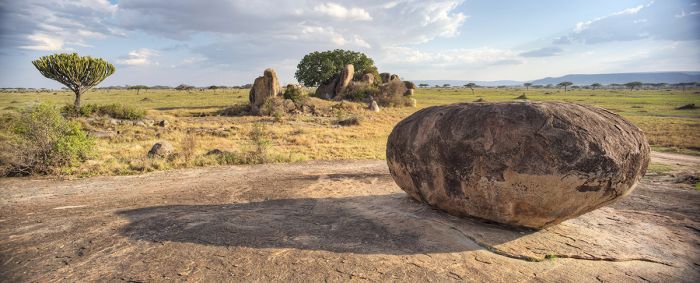
Moru Kopjes are a mystical place in the southern Seronera and very close to Dunia Camp.
Besides for the perennial Mbalageti and Orangi Rivers (both of which are small streams really and only flow during the rainy season), there is very little permanent water in Seronera. Lake Magadi, a small saline pond of water fed by the Mbalageti River, supports superb bird life when water levels are sufficient, including flamingos in the many hundreds. Seronera's landscape is characterized by areas of Acacia woodland interspersed with grasslands. Sparse riparian woods grow along the river courses.
The Serengeti's National Park Headquarters are located in Seronera and its Seronera Visitor Centre offers permanent displays and exhibits, a shop, video screenings, and information on wildlife sightings and road conditions. The park's staff village is located here as well.
It is worth noting that because Seronera is the most accessible part of the park and also has a high density of safari lodges and camping sites, it is usually the busiest sector in terms of vehicles and tourist numbers.
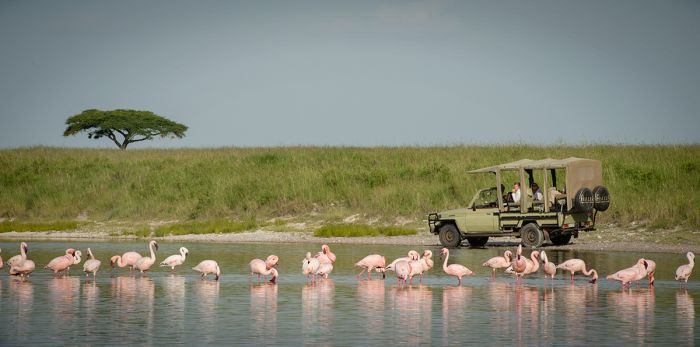
Lesser flamingos in Lake Magadi near Dunia Camp.
The Great Migration
One of nature's greatest living spectacles is the Great Migration, a term given to describe the year-long, circular, clockwise march of over two million herbivores across the Serengeti and Masai Mara grasslands. The migration animals are made up entirely of two species: the blue wildebeest and the plains zebra (the majority of which are wildebeests).
The migrating herds follow their instincts to seek out fresh grazing and so the migration is ongoing, with the herds ever moving and taking a full year to complete a cycle across the Serengeti and Masai Mara. The animals move not as one herd, but as tens of thousands of animals in multiple herds of various sizes and spread out for many miles as they move.
The wildebeests and zebras take advantage of strongly seasonal conditions, spending the wet season (November through May) on the plains of Tanzania's Serengeti and the dry season in Kenya's Masai Mara. The wildebeests give birth between January and March on the short grass plains in the southern Serengeti.
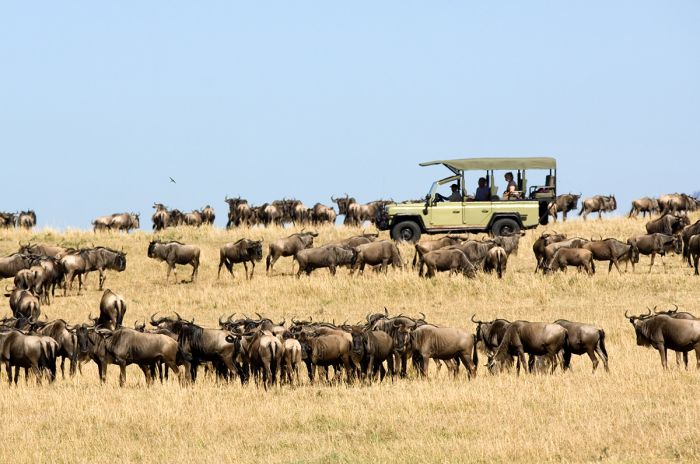
Game drive from Dunia Camp to see the great migrating herds.
The timing of the migration is rarely ever the same year-to-year, as local conditions influence grass growth and as such, the location of the bulk of there animals cannot be known precisely. Rains and other unknown conditions seem to direct the timing of the migration, but generally, it is known within several weeks when the animals will be in a general location.
The animals spread out to cover a vast area, but the main bulk of the animals moves south into the northern Serengeti around late-October and continue moving south towards the Serengeti's southern plains, arriving there sometime in January to graze on the rich grass growing on the volcanic soils. It is here on these short-grass plains, between January and early March, when the wildebeests give birth to their young en masse, producing some 500 000 baby wildebeests.
The herds remain on the southern short-grass plains until late March, giving the young animals time to grow and become strong, before heading north and west again. Many of the animals move towards the Serengeti's Western Corridor and Grumeti Reserve and the rest straight north into Central and Northern Serengeti, where they remain during June and into July. The herds move back into Kenya starting in late July, with the bulk moving into the Masai Mara in August.
Although many visitors time their visit to the Serengeti to coincide with the Migration, any region within the Serengeti offers very good wildlife viewing outside of the months when the migration may be present. This is because it is only the wildebeests and zebras that migrate, while the rest of the animals, including the major predators like lion, leopard, spotted hyena, and cheetah, as well as all the other herbivores, including springbok, gazelles, elephant, topi, hartebeest, and many others, do not migrate.
A popular aspect of experiencing the Great Migration is observing a herd as it crosses the Mara River, which requires animals swimming through waters inhabited by large Nile crocodiles that wait for a chance to get their first substantial meal in many months.
The dramatic river crossings (which take place along the Mara River in both Kenya and Tanzania) are certainly a spectacle and not for the faint of heart, with many of the wildebeest and zebras taken by crocs or succumbing to drowning or trampling in the chaos. The best chances for seeing a Grumeti River crossing is in June, while Mara River crossings are best in July and August.
ROOMS INCLUDES & EXCLUDES CHILDREN FACILITIES ACTIVITIES
Accommodation
8 guest accommodations in total comprising:
- 7 classic, Meru-style, canvas safari tents, six of which can be set up with a double or twin beds, and one of which can be a triple to accommodate a child under the age of 16 years.
- 1 double / family tent consisting of two bedrooms, one with a double bed (convertible to twins) and one with two single beds. The bedrooms each have their own en-suite facilities.
The tented rooms are all canvas and constructed atop elevated wooden platforms. Every tent includes en-suite facilities with plumbed hot and cold water, a double-basin vanity, indoor shower, and flush toilet. The tents are accessed via footpaths on the ground leading to the main camp area.
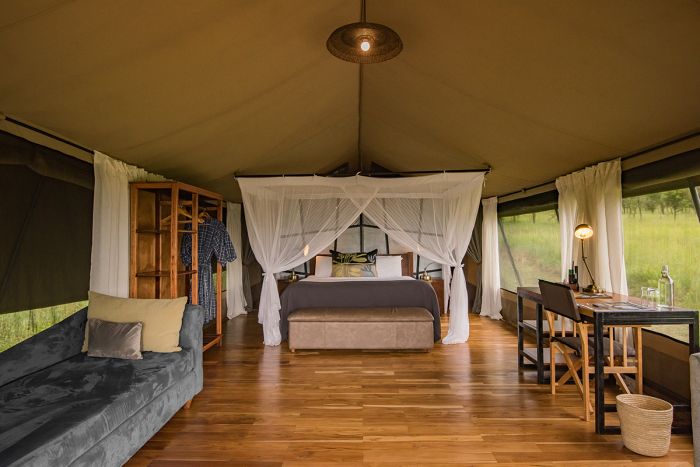
Guest tent interior at Dunia Camp.
The camp and tents are spread out amongst an open woodland with views onto the Serengeti grasslands.
Each guest tent has an indoor lounge area with a daybed, chairs, and writing desk at the front entrance that leads onto a split level outdoor deck with a double-wide daybed.
Other items and features in the guest tents include:
- Writing desk and chair.
- Lounge area with comfortable daybed.
- Clothes storage dresser.
- Mosquito netting over the beds.
- Safe.
- 24-hour power (provided using a combination of solar and generator) for lighting and charging electronics.
- Hairdryers are not supported by the solar / generator power system.
- WiFi available in the guest tents and main guest areas.
- Mobile phone signal available, but limited.
Dunia Camp can accommodate a maximum of 19 guests in total: 2 persons in each of the 7 standard tents (plus one additional child in a triple), and 4 persons in the family tent.
Includes & Excludes
Includes:
- All meals and house drinks, including wines, local brand spirits and beers, teas, and coffees.
- Safari experiences (twice-daily or full-day game drives and birding) accompanied by an experienced guide.
- Sundowner drinks and snacks.
- Laundry services are provided on a daily basis (weather permitting, items will be returned on the same day). Laundry is dried by the sun and on most days any laundry placed out in the morning will be returned by the evening.
- Wi-Fi access (throughout the entire camp).
- Seronera Airstrip transfers.
- Tourism Levy & VAT.
Excludes:
- Champagne, cognacs, fine wines, premium brand spirits, and cigars.
- Hot-air ballooning.
- Cultural community visits.
- Purchases from the Gift Shop.
- Any applicable wildlife fee, park fee, reserve fee, concession fee, other land-use fee.
Single Supplement
A single supplement may apply for any room booked by a single traveler; please ask us for pricing.
Children
Children aged 5 years and older are accommodated at Dunia Camp:
- 1 family tent and 1 standard tent available as a triple.
- Ask us about reduced rates for children sharing with adults or children 12-17 in their own tent.
- Children's menu available.
- Children under 5 years are allowed only if the camp is booked exclusively.
Game drives with children:
- During high and peak seasons, families (less than 5 persons) with children aged 0-12 years must pre-book a private vehicle.
- During low and peak seasons, families (less than 5 persons) with children aged 0-12 years will receive a private vehicle FOC subject to availability. Vehicle must be pre-booked.
- Year-round, families with children aged 0-12 years will receive a private vehicle FOC for every 5 persons in the family. This is subject to vehicle availability and must be booked in advance.
Facilities
The camp and tents are located in an open Acacia woodland with views onto the grasslands in the south-central Serengeti.
The main guest area consists of a large, wood-and-canvas structure atop a raised wooden deck and comprising a dining room, lounge, and bar. Roll-down canvas flaps lead onto an open-air viewing and dining deck.
Main guest area facilities include:
- The main guest area is a wood-and-canvas tented structure, open to the front where there is a viewing deck overlooking the Serengeti plains.
- The main guest space includes a dining area, lounge, and bar.
- The viewing deck is also used for dining.
- Dining is typically communal, but private dining is available on request.
- Campfire area.
- Gift Shop.
- Complimentary Wi-Fi access.
- Mineral water is provided in the main camp areas and in the guest tents.
- The camp is powered by a combination of solar and generator.
Activities
Activities included in the rate:
- Morning and afternoon/evening game drives in semi-open 4x4 vehicles.
- Bush meals and sundowners.
- Birding.
- Child-friendly activities.
- All game drive vehicles fitted with inverters for battery charging on game drives.
Optional activities at additional cost:
- Private activities are on offer (subject to vehicle availability, which needs to be booked in advance).
- Use of the customized Asilia photographic game drive vehicle. The vehicle is based at Namiri Plains, but also bookable from Dunia Camp. Maximum three photographers. Best to reserve in advance.
- Hot-air ballooning (may be booked in advance).
- Guided visit to a local community.
Example of a typical day:
- Early morning wake-up call. Morning wake-up and activity times vary according to the seasons, activities on offer, and wildlife sightings.
- Light breakfast before departing on the morning activity or food packed for an earlier departure.
- Return to the camp for a meal and rest period (full-day outings mean lunch is packed).
- Meet for afternoon tea and snacks (savory and sweet choices) before departing on the activity.
- Return to camp - freshen up or meet for drinks, followed by dinner.
- Enjoy a nightcap and/or discussion at the bar or around the campfire before retiring.
Great Good Fair Poor
- Jan
- Feb
- Mar
- Apr
- May
- Jun
- Jul
- Aug
- Sep
- Oct
- Nov
- Dec
General Tips
It is advised to avoid the Serengeti over March and April, when heavy rains typically occur. June to mid-October is excellent for general game viewing. The large herds of animals in the Great Migration usually cross into the Serengeti from Kenya's Masai Mara sometime around early October and move north back into Kenya around mid- to late-July.
Besides the Great Migration, the other big factor that impacts a stay in the Serengeti is rains. The region experiences most of its rain between November and May, but there are two somewhat distinct rain seasons, the 'short' rains and the 'long' rains (read more below).
Dunia Camp is open year-round (minimum 2 night stay).
Rains
Short Rains
The short rains occur for about one month sometime during November and December (the exact time varied somewhat year to year). This period is called the 'short' rains because the duration of an individual rain event is short and it is rare to have an all-day rain event. Most rain falls as an afternoon shower, while mornings are typically overcast or clear.
Long Rains
The long rains occur between March and May, with April being the wettest month of the year. During this tome, rain should be expected almost every day and the showers can last for hours at a time, although all-day rain is not typical. The roads in the Serengeti become muddy and very difficult in places, which can hamper game drives. Cloudy skies are typical and temperatures can be chilly at times.
The period between the short and long rains (January and February) also receives rain, but many days are clear and the amount and duration of the rain events is unpredictable, with some afternoon showers and the odd long and heavy rainfall event.
Temperatures
The temperatures in the Greater Serengeti do not experience wide fluctuation throughout the year, as the region lies between one and three degrees south of the equator. In general, daytime temperatures are comfortably warm and overnights and early mornings are chilly. Bring a fleece and rain jacket regardless of the timing of your visit.
Dry Season
The dry season (June to October) is sunny and warm most days and rarely hot. Rare rain showers can occur but are unlikely. From June thru August, the afternoon temperature averages 76-78°F (24-25°C), but some days can be warmer. Evenings and early mornings temperatures are often chilly, averaging 53-55°F (12-13°C).
September and October days are very pleasant, with temperatures averaging 80-83°F (28-30°C), with cool mornings persisting, averaging 53-56°F (11-13°C).
Rainy Season
The rain season is November through May (read more above) and the temperatures are fairly static throughout the season. Daytime temperatures average 79-83°F (26-28°C) and nighttime and early morning temperatures are chilly, but slightly warmer than the dry season, averaging 54-57°F (12-14°C)
The Great Migration
The annual movement of wildebeest and zebras across the Serengeti-Mara ecosystem is one of the greatest spectacles in the natural world. These large herds move in a circular track across southern Kenya and northern Tanzania, taking a full year to complete their cycle. The migration moves across both the Greater Masai Mara (in Kenya) and the Greater Serengeti (in Tanzania) in a fairly consistent pattern and timeframe. The animals move to take advantage of fresh grasses on which to graze.
The migrating herds of roughly 1.5 million blue wildebeests and several hundred thousand plains zebras spend about nine months of the year moving through Tanzania's Greater Serengeti and the other three months in Kenya's Greater Masai Mara. The migrating herds are in Tanzania's Greater Serengeti from sometime in October until around late-July (note that the timing is never precise and varies somewhat year to year). Note that the Serengeti is vast, and it is important to note where in the region the herds are located during this nine-month timeframe.
The animals spread out to cover a vast area, but the main bulk of the animals moves south into the northern Serengeti around late-October and continue moving south towards the Serengeti's southern plains, arriving there sometime in January to graze on the rich grass growing on the volcanic soils. It is here on these short-grass plains, between January and early March, when the wildebeests give birth to their young en masse, producing some 500 000 baby wildebeests.
The herds remain on the southern short-grass plains until late March, giving the young animals time to grow and become strong, before heading north and west again. Many of the animals move towards the Serengeti's Western Corridor and Grumeti Reserve and the rest straight north into Central and Northern Serengeti, where they remain during June and into July. The herds move back into Kenya starting in late July, with the bulk moving into the Masai Mara in August.
The migration is rarely ever the same in terms of precise timing and direction, as local rains and other conditions influence grass growth. The wildebeest may, therefore, move off the open plains earlier in some years and remain in the northern Serengeti for longer in others. Nonetheless, the best months for seeing the migration in the Southern Serengeti are in February and March, when the herds are adding new babies, in the Central Serengeti during May and June, when the herds are the most concentrated, and in the Western Corridor, Grumeti, and far Northern Serengeti from June thru August.
Many visitors hope to witness dramatic river crossings, when hungry crocodiles attack the herds as they swim across the dangerous rivers of the Northern Serengeti. Like the migration in general, the precise timing of the river crossings is never known from year to year, but crossings on the Grumeti River are usually best in June, while Mara River crossings are best in July and August.




